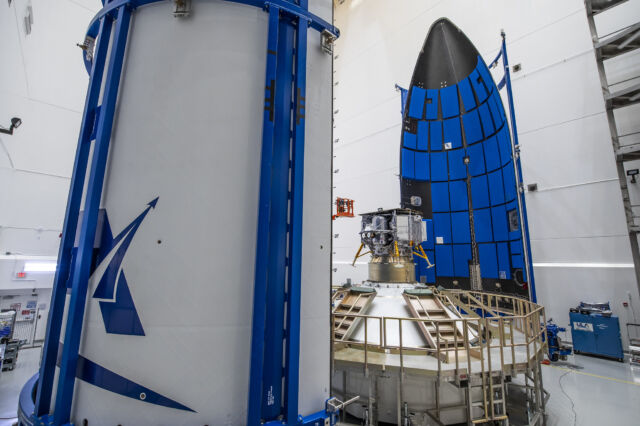For the first time, ULA’s Vulcan rocket is fully stacked at Cape Canaveral

United Launch Alliance’s first Vulcan rocket has been fully assembled at Cape Canaveral, Florida, in preparation for its inaugural flight next month.
Technicians hoisted the Vulcan rocket’s payload fairing, containing a commercial lunar lander from Astrobotic, on top of the launch vehicle Wednesday morning at ULA’s Vertical Integration Facility. This milestone followed the early morning transfer of the payload fairing from a nearby facility where Astrobotic’s lunar lander was fueled for its flight to the Moon.
ULA’s new rocket has rolled between its vertical hangar and the launch pad at Cape Canaveral Space Force Station several times for countdown rehearsals and fueling tests. But ULA only needed the Vulcan rocket’s first stage and upper stage to complete those tests. The addition of the payload shroud Wednesday marked the first time ULA has fully stacked a Vulcan rocket, standing some 202 feet (61.6 meters) tall, still surrounded by scaffolding and work platforms inside its assembly building.
This moves the launch company closer to the first flight of Vulcan, the vehicle slated to replace ULA’s Atlas V and Delta IV rockets. After some final checkouts and a holiday break, ground crews will transport the Vulcan rocket to its launch pad in preparation for liftoff at 2:18 am ET (07:18 UTC) on January 8.
The launch was previously scheduled for December 24, but ULA delayed the flight until the next launch window to resolve ground system issues uncovered during one of the recent Vulcan countdown rehearsals. Astrobotic’s first robotic lunar lander, named Peregrine Mission One, only has a few days per month when it can depart Earth and take a course toward the Moon. The launch and trajectory must be timed to allow the spacecraft to reach its landing site with the proper lighting conditions.
First full stack
United Launch Alliance, a 50-50 joint venture between Boeing and Lockheed Martin, has been under pressure from rival SpaceX for the last few years. While SpaceX has launched more than 90 times this year, ULA’s rockets have only flown three times as the company winds down its Atlas V and Delta IV programs.
One Delta IV-Heavy rocket remains in ULA’s inventory. It’s supposed to launch next year with a classified payload for the National Reconnaissance Office, the US government’s spy satellite agency. There are 17 Atlas V rockets left to fly.
With Vulcan, ULA is poised to ramp up its launch rate. Tory Bruno, the company’s chief executive, says ULA has sold 70 Vulcan launches—more than half to commercial customers and the rest to the US military. Amazon has booked 38 Vulcan missions to deploy satellites for its Project Kuiper broadband network. Vulcan will initially be fully expendable, but ULA plans to introduce engine recovery and reuse later this decade.
ULA’s goal is to launch an average of two Vulcan rockets per month by the end of 2025. This would be a remarkably fast launch cadence just two years after the first flight of Vulcan. For comparison, it took longer for the Atlas V rocket and SpaceX’s Falcon 9 to get to four flights.

The Vulcan rocket was originally slated to launch in 2019 but faced repeated delays, primarily due to late deliveries of rocket engines from Blue Origin, Jeff Bezos’ space company. ULA bypassed a launch opportunity in May after a Vulcan upper stage exploded during a ground test.
Unlike the debuts of most rockets, the Vulcan will launch with a functioning payload. Astrobotic’s uncrewed Peregrine Mission One will carry 20 payloads to the lunar surface, including five for NASA through the agency’s Commercial Lunar Payload Services (CLPS) program. This will be the first mission to launch under the CLPS initiative, which NASA set up in 2018 to purchase commercial transportation services to the Moon for scientific instruments and experiments.
https://arstechnica.com/?p=1992227